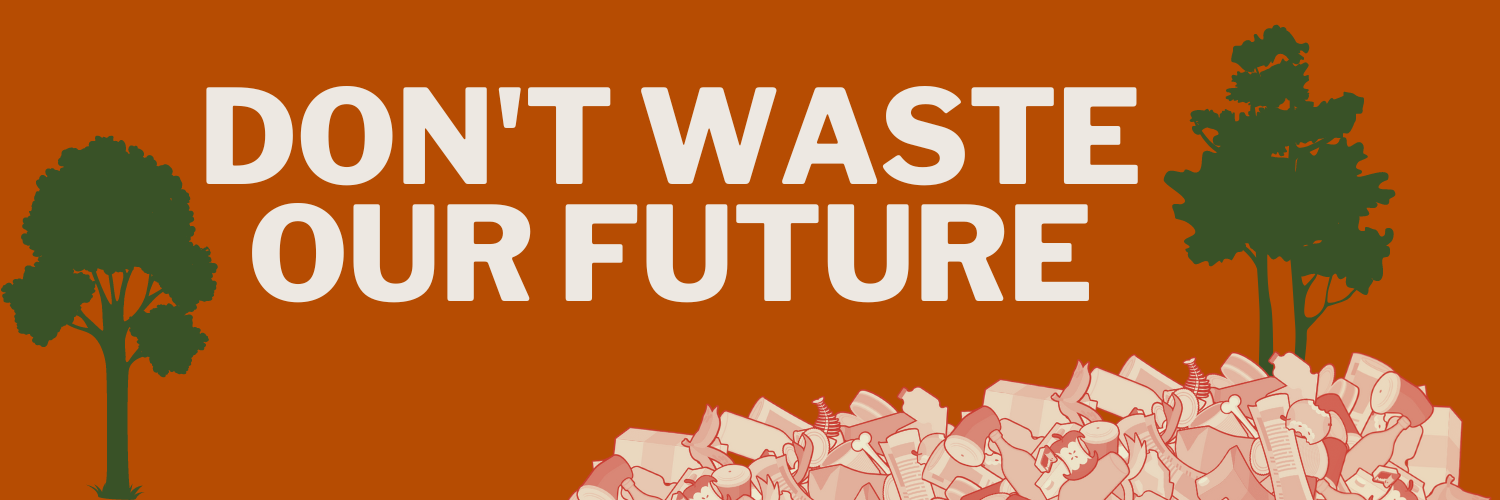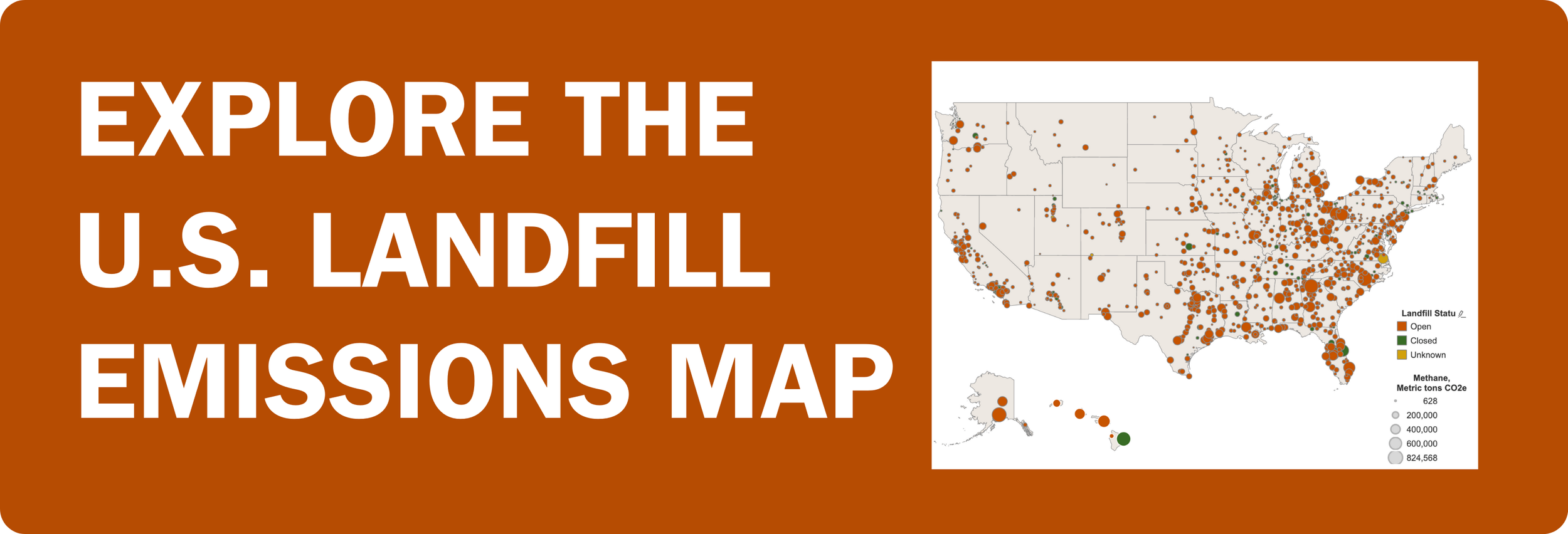Top 10 WAYS landfills impact the climate
1. The U.S. wasted 66.2 million tons of food in 2019. more food waste reached landfills than any other single material, making up 24 percent.
When food waste, with other organic waste such as paper and yard waste, decomposes in an anerobic landfill environment, it generates methane. In 2019, EPA estimates that 66.2 million tons of wasted food was generated in the food retail, food service, and residential sectors, and 59.8% of this waste was landfilled.
Methane’s impact on the climate is immediate and severe. Its 20 year warming potential is over 80 times more potent than carbon dioxide, and over 25 times more potent than CO2 in a 100-year timeframe.
Sources: EPA, 2019 Wasted Food Report, April 2023 and EPA, Sustainable Management of Food Basics
2. In 2022, landfills were the third largest source of methane in the U.S.
U.S. municipal solid waste (MSW) landfills emitted approximately 295 million metric tons of CO2-equivalent of methane per year, on a twenty-year warming potential timeframe.
295 million metric tons of CO2-equivalent is equal to about 66 million passenger cars driven in one year.
On a 100-year warming potential timeframe, MSW landfills emit over 100 million metrics tons of C02-equivalent of methane. Landfill methane emissions are likely even higher than the current formula-based estimates, as the formula relies on flawed assumptions and is too simplistic.
Source: EPA 2021 GHG Inventory. Emissions are based on reported formula-based estimates from landfills. 20-year horizon calculated based on the Intergovernmental Panel on Climate Change’s (IPCC) 6th Assessment on methane’s global warming potential (GWP).
3. top 10 states in total METHANE emissions from landfills Are:
Source: Industrious Labs’ data analysis of EPA GHGRP 2022 data
4. In 38 states, a municipal solid waste landfill was the number one largest industrial emitter of methane in 2022.
Source: Industrious Labs’ data analysis of EPA GHGRP 2021 data. Industrial emitters include chemical manufacturing, food processing, metals, minerals, mining, other manufacturing, petroleum and natural gas systems, petroleum refineries, pulp and paper and waste.
5. Landfills can perpetuate racial and economic discrimination.
54 percent of landfills reporting to the Greenhouse Gas Reporting Program are surrounded by communities (within a 1-mile radius) that have a higher percent of residents who are people of color or considered low-income residents than the national average. Landfills are more likely to be in communities of color when they are in densely populated areas.
Source: Environmental Integrity Project, Trashing the Climate, May 2023.
6. the waste generated in a state can end up in another state’s landfill.
14 states are net-exporters of waste (sending their trash to other states) and 16 states are net-importers of waste (taking in trash from other states.)
Don’t assume that the residents of the state are responsible for generating all of the trash and organic waste in landfills. Data on waste exports and imports is limited, but according to a 2013 industry survey by the Environmental Research and Education Foundation, New York, New Jersey and Maryland, export the most trash, and Pennsylvania, Ohio, and Virginia import the most municipal solid waste from other states..
Source: EREF, Municipal Solid Waste Management in the U.S., 2010 and 2013.
7. when landfills have detectable methane plumes, they’re much bigger on average than oil and gas wells, dairy, or energy sources.
A research study that overflew 270,000 industries found that when landfills have big methane plumes, they are, on average, very large: Much bigger than oil and gas wells, dairy, and energy industry sources. Energy, dairy, oil and gas point sources had the majority of their detected methane emissions between 10-100kg an hour. Landfills were the exception: the majority of their emissions are well above 100kg an hour (100kg an hour is the definition of a ‘super emitter’ according to EPA draft oil and gas rules), and many detected emissions are above 1,000kg an hour. That’s 10-100 times bigger, on average. Learn more here.
Source: California Air Resources Board, Landfill Methane Workshop, December 2022.
8. epa regulations fail to adequately control methane emissions from landfills.
Federal regulations are weak and due to high thresholds don’t even apply to many landfills that generate methane.
Voluntarily reported data to EPA's Landfill Methane Outreach Program estimates that 46% of landfills reported non-existent landfill gas collection at their facility.
Environmental Integrity Project’s analysis of publicly available data found that out of the top 10 highest emitting landfills in the country only eight are required to install and operate gas collection systems, while two don’t meet current federal thresholds.
Source: Industrious Labs data analysis of EPA GHGRP 2021 and EPA LMOP data, retrieved in August 2022 and Environmental Integrity Project, Trashing the Climate, May 2023.
9. recent aerial surveys reveal persistent methane super-emitter activity at many waste sites across the country that are not captured in formula-based estimates.
For example, a study on methane super-emitter activity in California, published in Nature in 2019, did survey flights over 272,000 industry infrastructure elements, using Next Generation Airborne Visible/Infrared Imaging Spectrometer. According to the study, “Methane point-source emissions in California are dominated by landfills (41 per cent), followed by dairies (26 per cent) and the oil and gas sector (26 per cent).” The authors found that “Methane ‘super-emitter’” activity occurs in every sector surveyed, with 10 percent of point sources contributing roughly 60 percent of point-source emissions.
Source: NPR, July 13, 2021 report: “Your Trash is Emitting Methane in the Landfill. Here’s why it matters.” and Nature, “California’s Methane Super Emitters”, November 2019
10. active landfills make up the majority of waste emissions.
There are about 1,280 active, or in use, municipal landfills throughout the country and about 1,330 closed landfills. According to data reported to the EPA, active landfills generate the majority of emissions. However, closed landfills can continue to generate methane emissions for decades.
Source: Industrious Labs data analysis of EPA GHGRP 2021 and EPA LMOP data, retrieved in August 2022.





